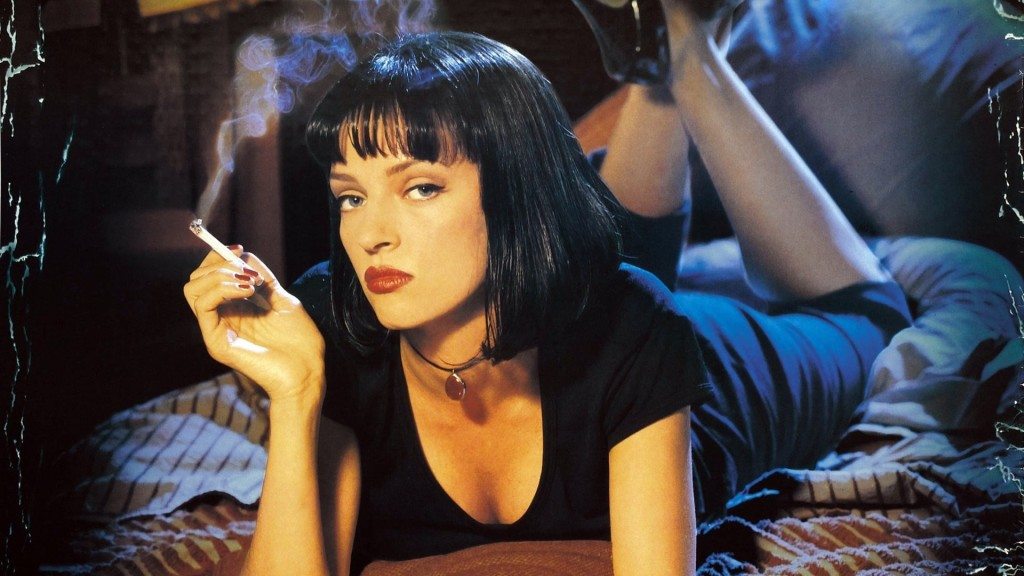American film critic Kenneth Turan in his review of Quentin Tarantino’s ‘Pulp Fiction’ wrote “The writer-director appears to be straining for his effects. Some sequences, especially one involving bondage harnesses and homosexual rape, have the uncomfortable feeling of creative desperation, of someone who’s afraid of losing his reputation scrambling for any way to offend sensibilities.” Perhaps this is what makes ‘Pulp Fiction’ one of the greatest films of all time. Its deep foundation of graphic violence and grotesqueness does not make ‘Pulp Fiction’ a gore fest.
Co-Written by Quentin Tarantino and Roger Avary, ‘Pulp Fiction’ is a crime film which follows two mob hitmen, Jules and Vincent essayed by Samuel L. Jackson and John Travolta, a boxer, Butch essayed by Bruce Willis, a gangster’s wife, Mia, essayed by Uma Thurman and a pair of diner bandits, Ringo and Yolanda, essayed by Tim Roth and Amanda Plummer, intertwine in four tales of violence and redemption.
Often seen as a cultural phenomenon, ‘Pulp Fiction’ swept awards in 1994. A recipient of the prestigious Palme d’Or, the Academy Award for Best Original Screenplay and BAFTA for Best Supporting Actor, received by Samuel L. Jackson, ‘Pulp Fiction’ is a combination of a coherent screenplay and dynamic performances.
The Narrative
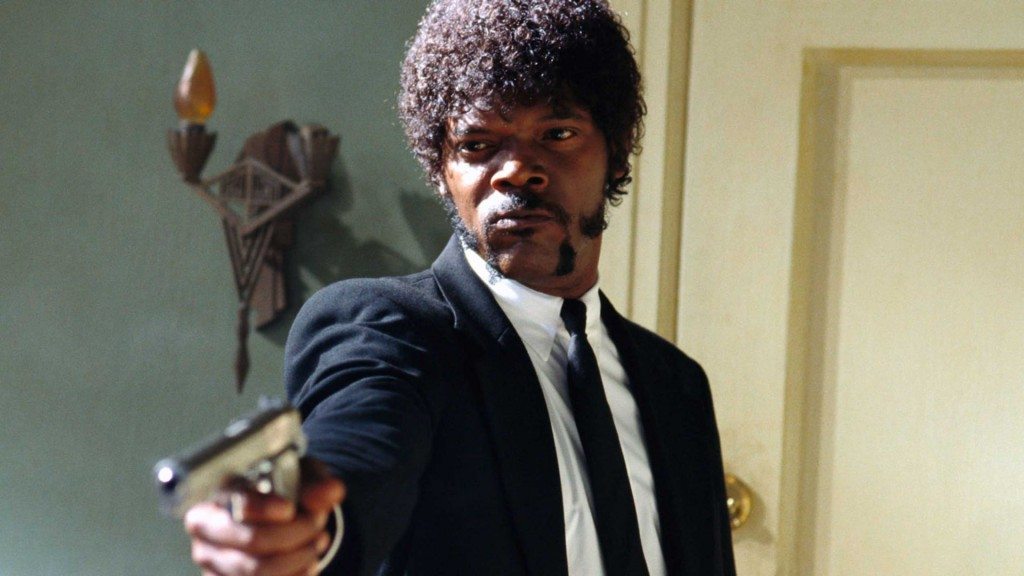
Quentin Tarantino, since his debut in 1992 with ‘Reservoir Dogs’, has come to be known as the leading figure in nonlinear storytelling. His unique style of jumping time frames to structure a coherent story allows the director to indulge in the depths of the criminal world with dexterity.
‘Pulp Fiction’ is a great piece for understanding the relationship shared between popular culture and cinema. ‘Pulp Fiction’ is the archetypical product of Tarantino. The film pays an intensive focus on human conversations and the sudden loss of interest of human psychologically. Throughout the film, the characters engage in a sudden chat, which has often nothing to do with the problematic situation. Whether discussing the quality of coffee while disposing off a body or appreciating a burger just before a shooting massacre, ‘Pulp Fiction’ is unsettlingly comical.
The film’s stinging combination of humour and eye-popping violence earned it a mass following, with many calling it as Tarantino’s cinematic masterpiece. The film’s celebrated screenplay and narrative structure swept the art of filmmaking; breathing new life in independent and parallel cinema and re-inventing postmodern literature.
‘Pulp Fiction’ adopts a “frame narrative” to divide the primary narrative into seven distinctive parts –
- “Prologue – The Diner” (i)
- Prelude to “Vincent Vega and Marsellus Wallace’s Wife”
- “Vincent Vega and Marsellus Wallace’s Wife”
- Prelude to “The Gold Watch” (a – flashback, b – present)
- “The Gold Watch”
- “The Bonnie Situation”
- “Epilogue – The Diner” (ii)
Frame narrative is a literary technique where one story is divided into multiple stories which gradually and eventually interweave the whole concept. Frame narrative has often been applied and experimented in literature. One of the earliest examples of Frame narratives are Sanskrit epics such as ‘Ramayana’, ‘Mahabharata’, and ‘Panchatantra’. This literary technique over a period of time penetrated into other parts of the world, creating works such as Homer’s ‘Odyssey’ and the Middle Eastern folk tales ‘One Thousand and One Nights’.
Frame Narrative, while being quite prevalent in literature, did not see much light in cinema. This all changed in the 90s as Quentin Tarantino brought in a new wave of a narrative. While directors did employ frame narratives, the complex structuring often made it difficult for them to design the plot. Tarantino, gaining reputation for his intricate and quirky writing, brought in what critics call – “Nonlinear narratives”.
Tarantino used this structuring in his debut flick ‘Reservoir Dogs’ (1992) where the perpetration of the heist was slowly unfolded through a series of multiple flashbacks. The director further exploited his narrative style of nonlinearity in ‘Pulp Fiction’. So, the seven sequences, when ordered chronologically, would run as “4a, 2, 6, 1, 7, 4b, 3, 5”.
The film is known for its snappy dialogues, quirky characterization and an overplaying narrative. If we see the film through its visual spectrum, ‘Pulp Fiction’ introduces viewers its first characters – Ringo a.k.a. “Pumpkin”, essayed by Tim Roth and Yolanda a.k.a. “Honey Bunny”, essayed by Amanda Plummer – a burglar couple. However, as the film further progresses, we get to know that it’s the fifth event of the film. This shift of narrative is important to a Tarantino as the event of “The Diner” focuses on two crucial aspects – the arduous work done by Jules and Vincent to clean up the mess they created by accidentally killing Marvin and Jules’ decision of quitting the business after surviving a shooting. The two events are important as they set the tone of characterization for Jules.
The Plot and the Style
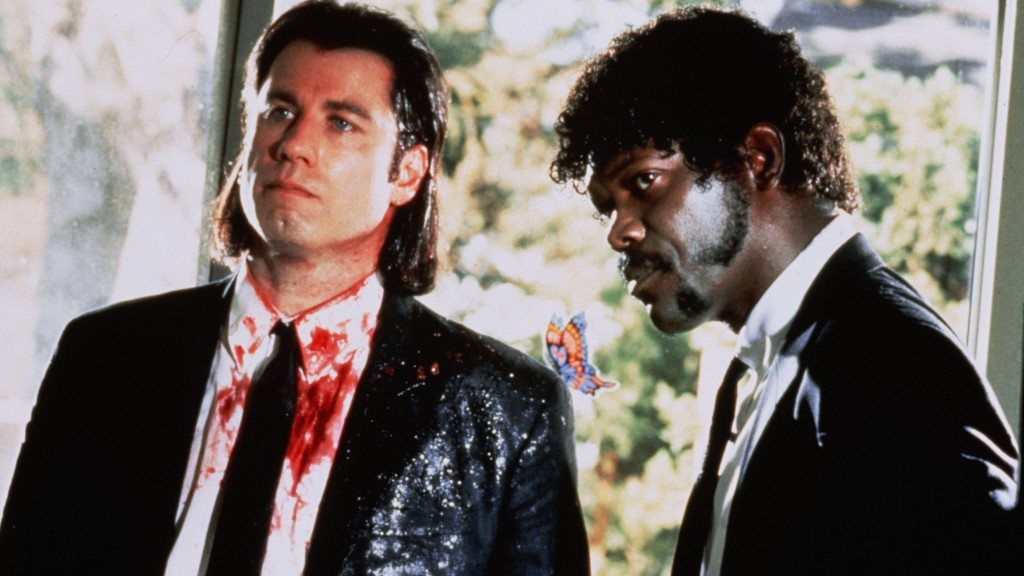
Tarantino has grown to be known as an auteur of violence. His distinctive voice of stylizing violence has become a trademark in his films. The director seems to balance the violence, crass language and jump shocks by settling them through nonlinear storytelling. So if we club the “The Bonnie Situation” and the “Prologue and Epilogue – The Diner”, the violence can overtake the story, a factor which Tarantino is aware of. So, in “Epilogue – The Diner”, Tarantino subverts the seething violence of the preceding events to elevate the tension in the Mexican standoff in the diner.
Tarantino, in an interview with “New York Times” said, “I got the idea of doing something that novelists get a chance to do but filmmakers don’t: telling three separate stories, having characters float in and out with different weights depending on the story.”
This is what Tarantino intends to do, i.e. create circumstances which would affect our perception of the characters. In the “Epilogue – Diner”, Jules recites the Biblical passage Ezekiel 25:17, which he also recited earlier before killing Brett –
“The path of the righteous man is beset on all sides by the iniquities of the selfish and the tyranny of evil men. Blessed is he who in the name of charity and goodwill shepherds the weak through the valley of darkness, for he is truly his brother’s keeper and the finder of lost children. And I will strike down upon thee with great vengeance and furious anger those who attempt to poison and destroy my brothers. And you will know my name is the Lord when I lay my vengeance upon thee.”
The question is – why is this passage so impactful and important to that Jules’ character? – It shades Jules as the calm composed messenger of God. Throughout the film, we see a continual focus on the spiritual and transcendental. When the two hitmen, Jules and Vincent, go to Brett’s house to retrieve Mars Marsellus’ briefcase, the two of them seem to be relaxed and laidback. Conversing about burgers and television, Jules and Vincent are most unassuming hitmen. As they enter the house, the scene does not take a leap and is constant.
However, as the scene progresses, the tension elevates and Jules takes charge of the narrative. This is an important character arc as it unfurls the tonality of ‘Pulp Fiction’ – a crime film paying homage to the hardboiled crime novels. As Jules and Brett engage in a casual conversation about “Big Kahuna Burgers”, Tarantino breaks the momentum of “casualness” to jump into the world of crime. Shooting Brett’s associates the scene suddenly jumps into hardcore tension and crime. The camera pans onto Jules’ face as he recites Ezekiel 25:17 and hoists the pressure. Jules’ voice rises and Brett’s face contorts with fear. Ending with – “And you will know my name is the Lord when I lay my vengeance upon thee.” – Jules shoots Brett, culminating the scene and kicking off the tonality which now the narrative adapts into.
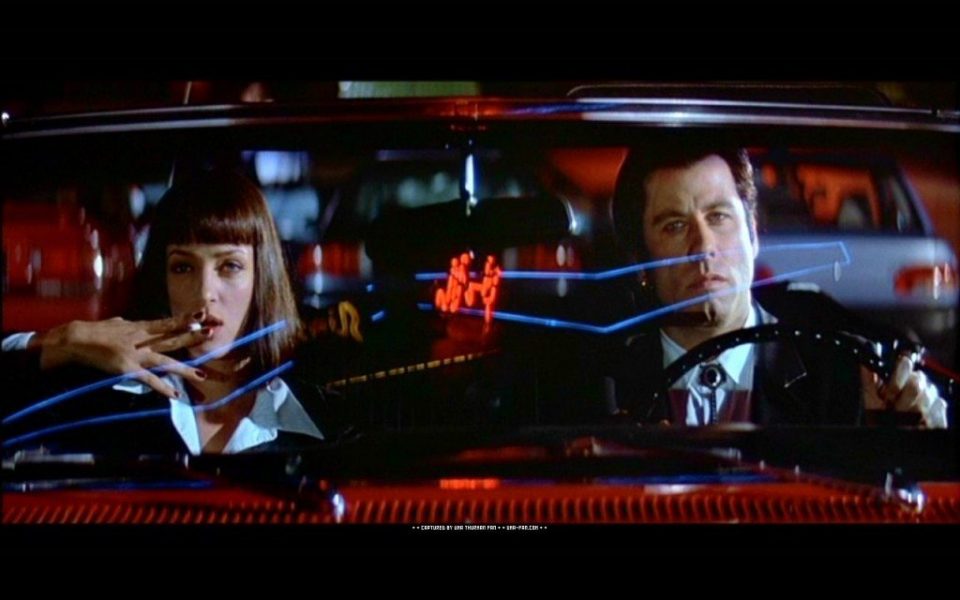
As the film progresses into gut-wrenching violence and gore, Tarantino suddenly subverts the flashy intensity with understated drama with the last segment of the film – “Epilogue – The Diner (ii)”. This scene, when put into chronological order, builds up with Ringo and Yolanda planning the robbery; and Jules and Vincent surviving the shock of killing Marvin and cleaning up the huge mess. The scene provides two spectrums of criminality – one duo charged with the adrenaline and the other drained of it. As Ringo attempts to bully Jules, he is quickly put at the receivers end. Jules, claiming to have had a “moment of clarity”, engages in a dialogue with Ringo and repeats Ezekiel 25:17. But now, the scene completely changes Jules’ character arc. While he is the daunting overlord in the earlier scene, Jules is calm and composed. His whole speech is the same, but with one change – the last line – “And you will know I am the Lord when I lay my vengeance upon you.” This creates a personalized account and forms the thematic framework of ‘Pulp Fiction’, i.e. personalization.
And that is what ‘Pulp Fiction’ is all about. It isn’t about hitmen killing people or characters going through life-threatening circumstances. It is about people living under the façade projected to the outer world. The film’s essence of punchy dialogues and comic conversation seeped in pop-cultural allusions reveal each character’s perspective spanning over different subject matter.
As the film slowly progresses, personalization becomes ever more obvious. The narrative structure of personalization reaches a pinnacle with the segment “Prelude to The Gold Watch (a – flashback, b – present)” and “The Gold Watch”. In these two segments, it is revealed that Butch Collige, essayed by Bruce Willis, is a boxer who double-crosses gagster Marsellus Wallace to win and accidentally kill his opponent. As Butch gets ready to leave the two with his girlfriend, he gets to know that she forgot to bring his gold watch which belonged to his father. As they are temporarily living in some other house, in order to evade the criminals, Butch gets infuriated with her. He decides to risk his life in order to procure the watch, which as the preceding segment reveals, is his only memory of his father. The tension elevates as well as the stakes do. Butch’s personalized identity forms another arc of his character. A hardened boxer who kills a man during a fight is emotionally attached to a watch. As the segment progresses, Butch is successful in procuring the watch, killing Vincent while doing so.
The arc of Butch’s personalization culminates and Marsellus’ kicks off. As Marsellus, who spots Butch driving off from his house, attempts to shoot him, the two get caught by Zed and Maynard, who brutally rape Marsellus, therefore damaging his dignity. The identity theme of personalization is transferred from Butch to Marsellus. As the gangster is raped, Butch manages to escape the basement but decides to save Marsellus. Bringing a katana with him, Butch kills Maynard and allows Marsellus to deal with Zed. The act is a sudden wave of transformation which is sparked off by the theme of personalisation. Marsellus allows Butch to flee the town as a reward – concluding personalization.
The Ending
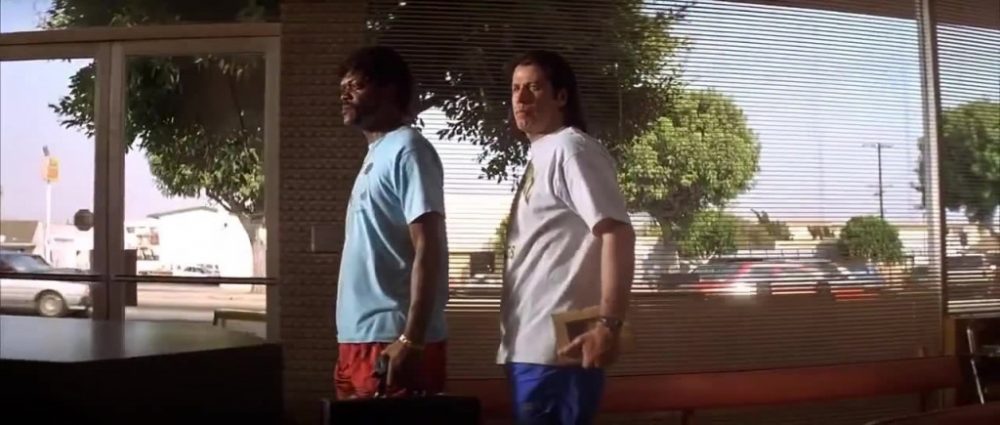
The nonlinearity brings in context to the characters which help Tarantino build up to the ending. The narrative style of nonlinearity brings in a microscopic focus onto the character build-up. One of the key things which allow Tarantino to jump timelines is its adherence to postmodernism. A late 20th-century movement, Postmodernism did away with grand narrative and indulged into simplistic styles of writing. ‘Pulp Fiction’, through the progression, it becomes increasingly self-referential and inter-textual.
Tarantino designs ‘Pulp Fiction’ on “Freytag’s Dramatic Arc”. Gustav Freytag was a German novelist and playwright who in 1894, in his book ‘Technique of the Drama’, deconstructed drama into three distinctive parts – exposition, climax and resolution. He took Aristotle’s ‘Poetics’ in which he put forth the idea of a drama being “…a whole is what has a beginning and middle and end.” So, in ‘Pulp Fiction’, Tarantino divided the film into multiple narratives to the give the aforementioned microscopic view of the characters juxtaposed to the circumstances and events.
What makes ‘Pulp Fiction’ such an invigorating watch is the fact such it has no “ending”. While it may seem that if the events are put into chronological order, one could decipher the end. However, the Post-modernistic tendencies structure the events as a mundane experience. With every character working in profession representing the other spectrum of society – criminality – the events taking place are just a physical manifestation of their life. Jules, who is the dramatic overbearing figure, has to use his words to prevent a robbery. Butch, who is the physically robust figure, has to use his physical power to save himself from getting raped by Zed. Ringo and Yolanda, who are the partners in crime, are faced with the conundrum of survival against the barrel of a gun.
Quentin Tarantino has seasoned to be one of the most exciting directors of modern cinema. His novelistic treatment of the screenplay makes his film and characters stimulating and engaging. Jumping forth timelines, Tarantino has pioneered the new wave to storytelling techniques which have been followed ever since.
Read More in Explainers: The Sixth Sense | The Shawshank Redemption | First Reformed

